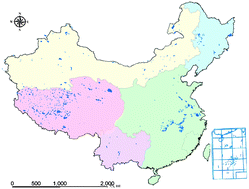The characteristics of organic phosphorus (Po) fractions in the sediments of nine lakes from the middle and lower reaches of the Yangtze River region, Yungui Plateau, Qinghai–Tibet Plateau, Northeast China Region, and Mongolia–Xinjiang Plateau, China were investigated and the differences of the different lakes on P fractionation was discussed. The results indicated that organic matter (OM) showed significant positive correlations with Po in sediment samples, and the rank order of the Po fractions was: residual Po > HCl–Po > fulvic acid–Po > humic acid–Po > NaHCO3–Po with mean relative proportions 7.4 : 3.4 : 2.4 : 1.7 : 1.0. The labile and moderately labile Po were the main fractions in the sediments for shallow eutrophic lakes except for Lake Qilu, however, nonlabile Po was dominant in the sediments from deep lakes. Labile Po was significantly correlated with total phosphorus (TP), inorganic phosphorus (Pi), Po, NaHCO3–Pi, HCl–Pi and NaOH–Pi, and the nonlabile Po was significantly and positively related to OM, TP, Po and NaOH–Pi.

You have access to this article
 Please wait while we load your content...
Something went wrong. Try again?
Please wait while we load your content...
Something went wrong. Try again?


 Please wait while we load your content...
Please wait while we load your content...